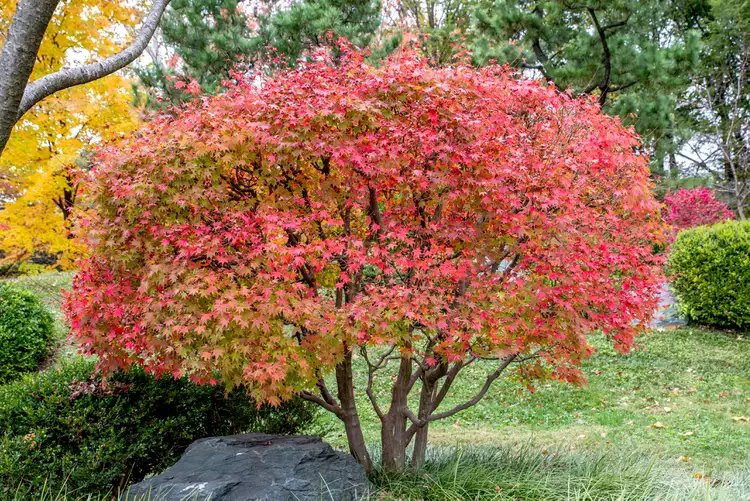
East Asian-born Japanese maple trees are a common element of traditional Japanese garden and landscaping designs. Japanese maples are frequently used in bonsai and praised for their low maintenance requirements and stunning autumn foliage.
Japanese maple trees come in a variety of sizes, including small trees, shrubs, and miniature dwarf trees. The form may be round, mounded, shaped like a vase, cascading, or upright. The shape could also be weeping. Common kinds have descriptive names that make reference to their colouring, such as “Bloodgood,” “Crimson Queen,” and Japanese maple trees with coral bark.
Japanese maple trees are well known for their eye-catching leaves. The five to nine palmate lobes on a Japanese maple leaf might be green, red, or both colors. Japanese maple leaves change in the autumn to magnificent hues of red, orange, yellow or purple. Their texture varies, with some having broad lobes, some having finely dissected lobes and some having a lacy, wispy appearance. The tiny, unnoticeable red or purple blossoms develop into samaras, which are half-inch long helicopter seeds that flutter in the wind as they fall from trees.
Care Requirements
The Japanese maple is a little tree that can be placed in practically any yard, and maple trees are lovely additions to any landscaping scheme. Although they have a reputation for being picky, they are actually not that difficult to care for if you plant them in their ideal conditions. They grow slowly to moderately, so you’ll need to have some patience.

Light
In part shade to filtered sun, cultivate Japanese maple. It is an excellent tree for full shade if required, especially in the warmer zones, but before buying one, do some research because different cultivars have varied requirements. Any cultivar rarely tolerates afternoon sun, which frequently results in sunburned Japanese maple leaves.
Soil
Japanese maple trees prefer soil that is both compost-enriched and moist but well-drained. Although sandy and loamy soil will fine, avoid soil with a high alkalinity level because Japanese maples like a slightly acidic environment. Japanese maple trees can also thrive in poor soil, although they will develop more slowly and may experience stress.
Water
Although well-draining soil is preferred by Japanese maples, they also enjoy routine watering. Mulching is the simplest approach to control the amount of moisture in the soil around a Japanese maple. When the earth feels dry, especially when it hasn’t rained much, take the time to water your tree until it is well-established.
For the first month after planting, a tree needs water every two to three days. After that, it need water at least once per week, particularly when there is no rain or snow.
Anecdotal evidence suggests that reducing water in the late summer enhances autumn colour. No scientific research, however, supports the hypothesis.
Fertilizer
Don’t fertilize a newly planted Japanese maple and just feed it in the second year’s late winter or early spring. Put it in soil that has been supplemented with compost instead. Healthy trees with sufficient of organic matter in the soil do not require annual fertilization.
If fertilizer is required, apply it in the spring. Apply a granular slow-release fertilizer for shrubs and trees, combining it at half the rate advised for landscape trees. Avoid using liquid fertilizer since it can cause the roots to burn. Starting at least a foot away from the tree’s trunk and extending past its drip line, apply the fertilizer evenly all around the tree.
Table





